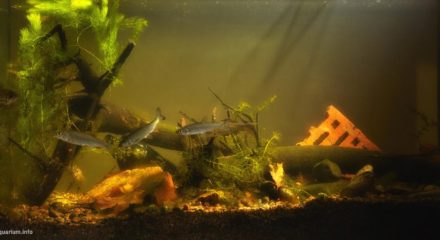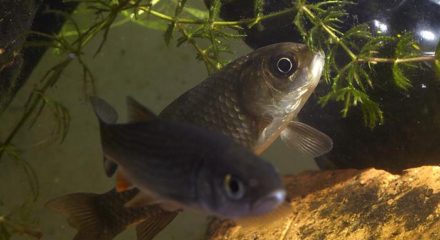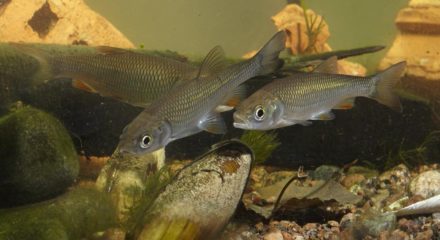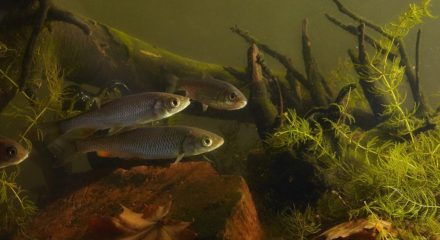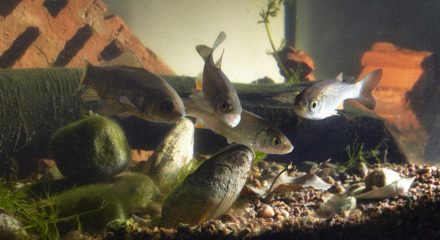Strelka River coastal part in village Ropsha, Leningrad Oblast, Russia
60th place in Biotope Aquarium Design Contest 2016
![]() Russia. Nil Filimonov
Russia. Nil Filimonov
Aquarium Volume: 200 L
Fish and invertebrates: Carassius gibelio, Squalius cephalus, Unio sp.
Plants list: Ceratophyllum sp.
Biotope description: Strelka River flows in the Leningrad region (northwest European Russia): originates at the Izhora plateau and flows into the Gulf of Finland. On its banks there are well-known historical settlement Ropsha and Strelna. Creating our aquarium, we had a goal to show the key ecological linkages in the coastal river community. Strelka is a river with moderate flow, water color is yellow due to the destruction of soil organic matter, the reaction is slightly alkaline. The soil is gravel mixed with sand. Hornwort dominate. On the banks of the river in Ropsha old trees grow (maple, willow). Their branches and driftwood in the water have a dark green color due to green algae. The latter serve as food for Planorbarius corneus. On the bottom there is leaf litter, water crustaceans (Asellus aquaticus), larvae of mayflies (eg, Cloeon). They all eat plant residues. There are chub (Squalius cephalus) and silver carp (Carassius gibelio) there. Fish are actively digging in the soil and feed on benthic invertebrates mentioned above. They also eat water plants. At the bottom Unio sp. crawl. They move slowly along the bottom, exposing the leg. Unio burrow into the ground, exposing the pointed rear end of the shell with two siphons: in (a fringed edge) and out. These mollusks pump water with suspended particles of food. Larvae prefer living on carp. Thanks to people in the Strelka River there are often foreign objects: bricks, bottles, tires, as well as plastpolymers and steel. Their influence is not clear: they affect the chemical composition of water, but serve as habitats for aquatic organisms. Gastropods and leeches, for example, lay their eggs on these subjects. Aquatic plants growing on objects over time enrich the biotope. Community are highly susceptible to human impacts, and, of course, needs to be monitored and protected.
Fish and invertebrates: Carassius gibelio, Squalius cephalus, Unio sp.
Plants list: Ceratophyllum sp.
Biotope description: Strelka River flows in the Leningrad region (northwest European Russia): originates at the Izhora plateau and flows into the Gulf of Finland. On its banks there are well-known historical settlement Ropsha and Strelna. Creating our aquarium, we had a goal to show the key ecological linkages in the coastal river community. Strelka is a river with moderate flow, water color is yellow due to the destruction of soil organic matter, the reaction is slightly alkaline. The soil is gravel mixed with sand. Hornwort dominate. On the banks of the river in Ropsha old trees grow (maple, willow). Their branches and driftwood in the water have a dark green color due to green algae. The latter serve as food for Planorbarius corneus. On the bottom there is leaf litter, water crustaceans (Asellus aquaticus), larvae of mayflies (eg, Cloeon). They all eat plant residues. There are chub (Squalius cephalus) and silver carp (Carassius gibelio) there. Fish are actively digging in the soil and feed on benthic invertebrates mentioned above. They also eat water plants. At the bottom Unio sp. crawl. They move slowly along the bottom, exposing the leg. Unio burrow into the ground, exposing the pointed rear end of the shell with two siphons: in (a fringed edge) and out. These mollusks pump water with suspended particles of food. Larvae prefer living on carp. Thanks to people in the Strelka River there are often foreign objects: bricks, bottles, tires, as well as plastpolymers and steel. Their influence is not clear: they affect the chemical composition of water, but serve as habitats for aquatic organisms. Gastropods and leeches, for example, lay their eggs on these subjects. Aquatic plants growing on objects over time enrich the biotope. Community are highly susceptible to human impacts, and, of course, needs to be monitored and protected.

